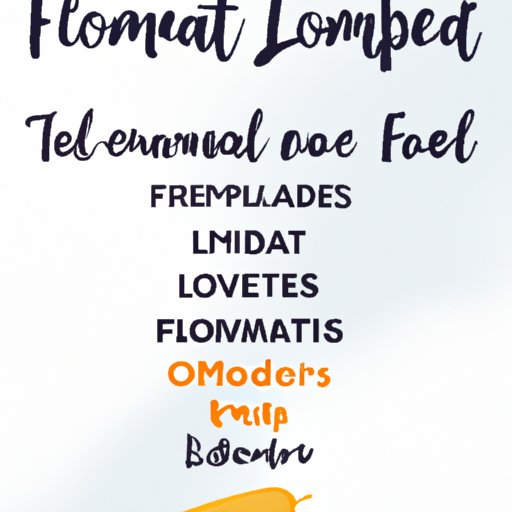Introduction
The Low FODMAP Diet is a popular dietary approach to managing gastrointestinal (GI) symptoms such as bloating, gas, abdominal pain, and diarrhea. It involves avoiding certain foods that are high in fermentable oligosaccharides, disaccharides, monosaccharides, and polyols (FODMAPs). By following this diet, many people have experienced significant improvements in their digestive health. In this article, we will explore the basics of the Low FODMAP Diet, its health benefits, foods to avoid, recipes, and compare it to other diets.
Body
Explain the Basics of the Low FODMAP Diet and Its Health Benefits
The Low FODMAP Diet was developed by researchers at Monash University in Australia as a way to manage GI symptoms. The goal of the diet is to reduce the amount of FODMAPs in your diet. FODMAPs are short-chain carbohydrates found in many foods that are poorly absorbed in the small intestine. They are fermented by bacteria in the large intestine, which can lead to increased gas production, abdominal distention, and other uncomfortable symptoms.
According to a study published in the journal Nutrition & Metabolism, following the Low FODMAP Diet has been shown to significantly reduce GI symptoms in those with irritable bowel syndrome (IBS). Furthermore, it may also help improve overall gut health by reducing inflammation and restoring the balance of beneficial bacteria in the gut microbiome.
The Low FODMAP Diet involves avoiding high FODMAP foods for a period of time, then slowly reintroducing them one by one to identify which ones trigger your symptoms. This process should be done under the guidance of a registered dietitian or healthcare professional.
Highlight Popular Foods to Avoid on the Low FODMAP Diet
There are several common foods that are high in FODMAPs and should be avoided on the Low FODMAP Diet. These include dairy products such as milk, yogurt, and cheese; certain fruits and vegetables such as apples, pears, onions, garlic, and artichokes; grains such as wheat, rye, and barley; legumes such as beans and lentils; sweeteners such as honey and agave; and processed foods such as sausages and store-bought sauces.
Fortunately, there are plenty of low FODMAP substitutes for these foods. For example, instead of dairy, you can use nut milks, coconut milk, or lactose-free milk. Instead of wheat, you can use gluten-free oats or quinoa. Instead of onions, you can use leeks or chives. And instead of honey, you can use maple syrup or stevia.
Provide a List of Recipes for Those Following the Low FODMAP Diet
Eating a Low FODMAP Diet doesn’t mean you have to give up flavorful, delicious meals. There are plenty of tasty recipes that are suitable for the Low FODMAP Diet. Some examples include spicy black bean soup, roasted vegetable stir fry, and zucchini noodles with pesto. You can also easily adapt your favorite recipes to make them low FODMAP friendly by substituting high FODMAP ingredients with low FODMAP alternatives.
Interview People Who Have Experienced Success with the Low FODMAP Diet
It can be helpful to hear from people who have successfully implemented the Low FODMAP Diet into their lifestyle. For example, one person reported that “I used to suffer from IBS and severe bloating, but since starting the Low FODMAP Diet, I have seen a huge improvement in my digestion. I have more energy, less pain, and just feel better overall.” Another person said “The Low FODMAP Diet has changed my life. I was able to find relief from my digestive issues and am now able to eat a variety of foods without experiencing any discomfort.”
Compare and Contrast the Low FODMAP Diet with Other Diets
The Low FODMAP Diet is similar to other dietary approaches such as the Specific Carbohydrate Diet (SCD), the Gut and Psychology Syndrome (GAPS) Diet, and the Paleo Diet. All of these diets focus on reducing inflammation and improving gut health, but they do so in different ways. For example, the SCD eliminates all grains, while the GAPS Diet focuses on healing the gut lining, and the Paleo Diet eliminates all processed foods.
The Low FODMAP Diet is unique in that it focuses specifically on reducing FODMAPs, which can reduce bloating, gas, abdominal pain, and diarrhea. However, it is important to note that, unlike the other diets mentioned, the Low FODMAP Diet is not an elimination diet. Rather, it is designed to help you identify which foods trigger your GI symptoms so that you can make informed decisions about what to eat.
Conclusion
The Low FODMAP Diet has been proven to be effective in reducing GI symptoms and improving overall gut health. It involves avoiding certain foods that are high in FODMAPs and substituting them with low FODMAP alternatives. Additionally, there are plenty of delicious low FODMAP recipes that can help make the transition easier. Finally, it is important to note that the Low FODMAP Diet is different from other diets in that it is not an elimination diet, but rather a way to identify which foods trigger your symptoms so that you can make informed decisions about what to eat.
(Note: Is this article not meeting your expectations? Do you have knowledge or insights to share? Unlock new opportunities and expand your reach by joining our authors team. Click Registration to join us and share your expertise with our readers.)

To date, there is no research to support that the GAPS diet can help treat the conditions it claims to. The diet has not been scientifically tested, and the only claims in support of this diet are anecdotal.
Thank you for sharing your perspective on this post. I can see how your point of view is well-informed and thoughtfully considered. I appreciate your engagement and willingness to share your opinion.